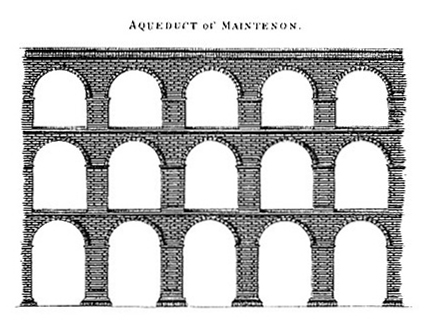1902 Encyclopedia > Aqueduct > Aqueducts Built in France in 17th-19th Centuries
Aqueduct
(Part 8)
Aqueducts Built in France in 17th-19th Centuries
In France various aqueducts have been formed after the manner of the Romans. The most remarkable are those constructed in the reign of Louis XIV., at vast expense, for conducting water from Marly to Versailles. The famous aqudeduct bridge of Maintenon, which was erected for conveying the waters of the River Eure to Versailles, it without doubt, in point of magnitude and height, the most magnificent structure of the kind in the world. In Plate IV. a view is given of a portion of this work, on the same scale as the others there represented. Had the whole been delineated on the same scale, it would have extended to four times the breadth of the plate. It extents about 4400 feet in length, that is, about five-sixths of a mile, is upwards of 200 feet in heights, and contains 242 arcades, each divided into three rows, forming in all 726 arches about 50 feet span. Of the subterranean aqueducts in France the finest is that of Arcueil, which serves to conduct water to that village. It is 44,300 feet in length, or upwards of 8 miles, extending from the valley of Arcueil to the castle at the gate of St Jaques, all built of hewn stone. It is about 6 feet in height, and has on each side a foot-path 18 inches wide; it has a declivity of 1 foot in 1300. Another aqueduct of this kind is that of Rocquancourt, part of the system which brings water to Versailles; it is 11,760 feet in length, or upwards of 2 miles, and has a declivity in its whole course of only 3 feet. In some parts of its course it was necessary to make excavations 80 or 90 feet deep, which rendered the execution very difficult.

Aqueduct of Maintenon, France
The great waterworks that supply the city of Marseilles with the water of the Durance, by a canal about 60 miles in length, are among the boldest undertakings of the kind in modern times. This canal, begun in 1839, and completed in 1847, is conveyed through three chains of limestone mountains by forty-five tunnels, forming an aggregate length of 8 miles, and across numerous valleys by aqueducts; the largest of which, the Aqueduct of Roquefeavour, over the ravine of the River Arc, about 5 miles from Aix, surpasses in size and altitude the ancient Pont du Gard. The immense volume of water, which passes at the rate of 198,000 gallons per minute, is carried across as in the old Roman aqueducts by a channel of masonwork. The height of this aqueduct is 262 feet, and its length 1287.
Read the rest of this article:
Aqueduct - Table of Contents
|
